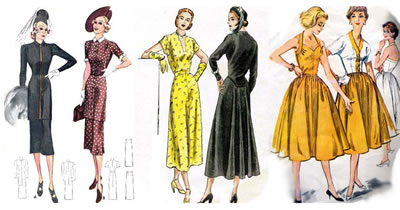 |  |  | |
 | The Commercial Pattern Archive has evolved over the past 29 years and, in keeping up with new technology, can now operate on a variety of systems. Patterns and images continue to be added to the database which started as a project of the Costume Design & Technology Commission. | |
| Commercial Pattern Archive Expands with Innovations The approaching USITT @50 celebration prompts reminiscences about the history of the Costume Design & Technology Commission’s Commercial Pattern Archive project. This project is not 50 years old, but it does reflect the amazing changes over the past 29 years. It began as the Flat Pattern Exchange with Kevin Seligman, Betty Williams, and Joy Spanabel Emery. The idea was to locate and share paper clothing patterns for production research and inspiration. Ms. Emery was the one fascinated with using the emerging computer technology to list the patterns for easy retrieval Ms. Williams with her vast collection of patterns and encyclopedic knowledge of pattern company histories. Mr. Seligman provided key information on the breadth of the industry and its' international influences. The computer segment slowly evolved from a DOS–based “flat” database through at least three different Windows-based applications. Fortunately all the data could be exported into the new applications. In 1999 volunteers began scanning the pattern designs and small-scale pattern pieces and linked them to the pattern records. This capability exploded the value of the database as a research tool. These developments were possible with major support from the USITT Endowment Fund, The Commissioner’s Fund, the National Endowment for the Humanities, and several other granting agencies as well as from the later proceeds from CoPA Vintage Patterns CD set. Ms. Williams died in 1997 and shortly afterward her collection of fashion publications, tailoring journals, related research, and patterns were donated to the University of Rhode Island. These were combined with the URI Theatre Pattern Collection, and Ms. Emery’s personal collection. Mr. Seligman’s vast collection of patterns and other related resources were donated to the Los Angeles County Museum Doris Stein Research Center. Patterns from all four collections are included in the database, CoPA, as are collections from other sources. Work contintues to compile a “union catalog” of pattern collections in the United States and elsewhere so researchers can find the original patterns closer to home. However, CoPA was limited to Windows systems only, and CDs we are able to make available contain a fraction of the records and images. This year there were additional major developments. There is now a database with over 48,000 records and 74,000 images available on the web. That means it is accessible on MACs as well as Windows. It is the entire and ever-expanding database with new records and images added weekly. CoPa is now able to accept credit cards as well as purchase orders and personal checks. The features are reflected on the enhanced web site www.uri.edu/library/special_collections/COPA. The online version is available at a graduated price scale for individuals and groups for set periods of time. The information can be used for design research, late 19th and 20th century costume history (especially for everyday wear), and dating patterns in personal collections. Patterns for costumes can be developed in the appropriate size by enlarging the small-scale pattern pieces, or the pattern schematic can be used as draping guides. The CD set with some of the database records can be used in the same way on Windows systems only. Information and order forms with pricing for both versions are on the website under Order Now. All the proceeds go directly to the Betty Williams Pattern Fund to pay students for data entry and scanning as well as programmers for enhancing and maintaining the database. The collection has come a long way from the early stage of the project. Much of what has been developed was barely a dream when it started. Who knows what opportunities the technology will present in the coming years. So, we make haste slowly. | ||